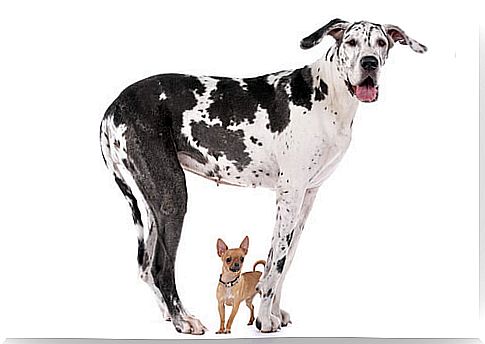Why Don’t Big Dogs Live As Long As Smaller Ones?

There is a phenomenon that is well known in the canine world: large dogs do not live as long as smaller ones. While small breeds have an average life expectancy of 12 to 14 years, larger breeds live between 8 and 10 years. The so-called ‘giant breeds’ only live for 5 to 8 years.
In the short term, large dogs may have an advantage in terms of their survival and reproductive opportunity. However, growing quickly and maintaining a large body size could come at the cost of reduced longevity.
The growth rate is very different between large and small dog breeds
It is a fact that larger dogs grow very fast. Think of a Great Dane: from birth to first birthday, they gain 100 times their weight.
In that same period of time, wolves increase 60 times and poodles only 20 times. Research in the last decade has suggested that larger subjects die younger because they have an accelerated growth rate.
Thus, some experts think that this increased activity is accompanied by a harmful increase in free radicals, which in theory would accelerate aging.

Cancer incidence in large dogs may count for shorter longevity
It is a fact that larger dogs are more prone to health problems such as developmental disorders and musculoskeletal diseases. They also suffer from more gastrointestinal ailments and tumors.
These diseases are related to their accelerated growth and appear to be the unwanted side effects of selective breeding of large organisms in the short term. In nature, the appearance of large subjects is due to evolution by natural selection, which takes long periods of time.
Remember that dog breeds were artificially created by humans to select their appearance or behavior and not necessarily health. The process required considerable inbreeding to produce ‘purebred’ dogs.
Now, beyond the simple breeding quirks that led to poor genetics and poor health, there are more general mechanisms that determine longevity.

Telomeres: genetic emblems of aging
It should be remembered that our genetic material, specifically DNA, is stored in cellular structures called chromosomes. Telomeres are the protective portions at the ends of these chromosomes. In young humans, for example, telomeres are about 8,000 to 10,000 nucleotides long. As you get older, your telomeres get shorter.
This occurs because telomeres are split or shortened with each cell division. This is important because, when telomeres reach a critically short length, the cell stops dividing and signals one of the signals to die.
So why don’t big dogs live as long as little ones?
In general, lifespan is often understood as the span of life to aging. What seems to be happening – which is why large dogs do not live as long as small dogs – is that they have to run their metabolism and growth mechanisms at high speed.
Cells divide rapidly to allow dogs to grow to their final size. Unfortunately, with each cell division the length of their telomeres is shortened a little, which accelerates them to aging. In turn, high cell turnover influences the emergence of various diseases, including cancer.
This is what is known so far: we do not yet have an entirely clear understanding of why growing faster leads to accelerated aging.









